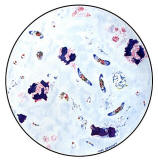| x | x | |||||
 |
 |
|||||
| Contact us | Today is | |||||
|
|
||||||
|
Micrograph from CDC
|
|
|||||
|
Parasitology Microscope Image Laboratory here |
THE CHAPTER NUMBERS ARE LINKED TO ILLUSTRATED HTML PAGES | |||||
| Please tell us where you come from or tell a friend about this book here | ||||||
|
CHAPTER ONE Intestinal and Luminal Protozoa |
Amebiasis (amebic dysentery, amebic hepatitis), Giardiasis (lambliasis): Epidemiology, morbidity and mortality. Morphology of the organisms. Life cycles, hosts and vectors. Disease, symptoms and pathogenesis. Diagnosis Prevention and control |
|||||
|
Please send comments and
|
||||||
|
CHAPTER TWO Blood Protozoa
|
Trypanosomiasis, Leishmaniasis, Malaria, Babesiosis, Toxoplasmosis,
Pneumocystsis pneumonia
|
|||||
| CHAPTER THREE The Molecular Biology of Trypanosomiasis | African and American
Trypanosomes.
The diseases that they cause. The molecular basis of antigen
variation. The mode of action of trypanocidal drugs |
|||||
| CHAPTER FOUR Nematodes | Intestinal
helminths: Epidemiology, morbidity and mortality. Morphology of the organism. Life cycle, hosts and vectors. Disease,
symptoms and pathogenesis. Diagnosis. Prevention and control |
|||||
| CHAPTER FIVE Cestodes | The tapeworms: Their
epidemiology and life cycles. The diseases that they cause: diagnosis,
prevention and control |
|||||
| CHAPTER SIX Trematodes | Schistosomiasis
(Bilharziasis), Fasciolopsis buski
(Giant intestinal fluke), Clonorchis sinensis
(Chinese Liver Fluke), Paragonimus westermani
(Lung Fluke) |
|||||
|
CHAPTER SEVEN PART ONE Arthropods
CHAPTER SEVEN PART TWO Ticks |
Fleas, lice, chiggers, bot flies and ticks | |||||
|
|
||||||
|
|
||||||
|
|
||||||
